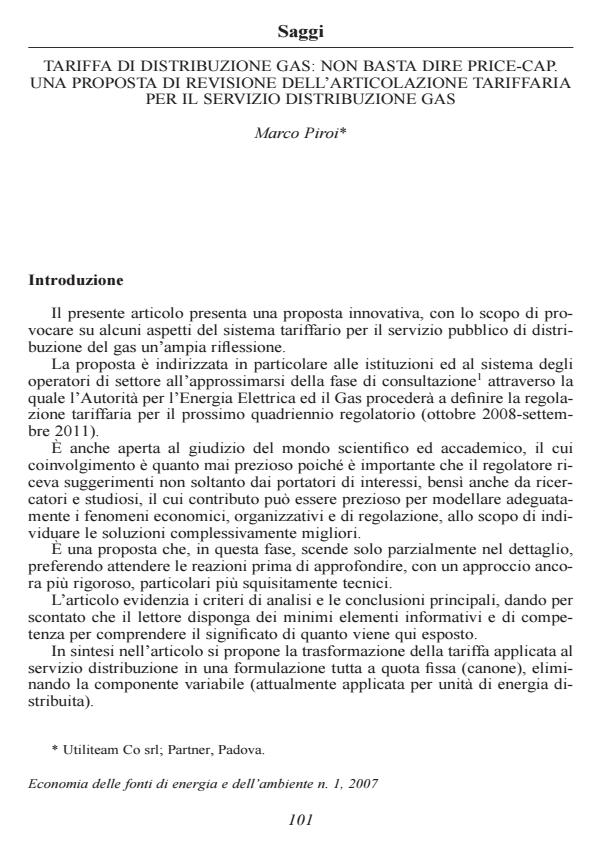Tariffa di distribuzione gas: non basta dire price-cap. Una proposta di revisione dell'articolazione tariffaria per il servizio distribuzione gas
Titolo Rivista ECONOMIA DELLE FONTI DI ENERGIA E DELL’AMBIENTE
Autori/Curatori Marco Piroi
Anno di pubblicazione 2008 Fascicolo 2007/1
Lingua Italiano Numero pagine 17 P. 101-117 Dimensione file 54 KB
DOI
Il DOI è il codice a barre della proprietà intellettuale: per saperne di più
clicca qui
Qui sotto puoi vedere in anteprima la prima pagina di questo articolo.
Se questo articolo ti interessa, lo puoi acquistare (e scaricare in formato pdf) seguendo le facili indicazioni per acquistare il download credit. Acquista Download Credits per scaricare questo Articolo in formato PDF

FrancoAngeli è membro della Publishers International Linking Association, Inc (PILA)associazione indipendente e non profit per facilitare (attraverso i servizi tecnologici implementati da CrossRef.org) l’accesso degli studiosi ai contenuti digitali nelle pubblicazioni professionali e scientifiche
Power Exchange, Day-Ahead Markets, Unilateral Market Power, Residual Demand, Lerner Index. di Mercato Unilaterale, Domanda Residuale, Indice di Lerner. Gas distribution tariff: saying price-cap is not enough (Marco Piroi) - This article faces the theme of the best tariff structure to be applied to the gas distribution via network service in Italy. First of all, it highlights the regulation objectives that the tariff structure must be designed to meet. It then proposes a revision of the current methodology with the purpose of pursuing said objectives in the best way with regard to the current rules. The tariff policy choices must reach various objectives, which have different relative importance and clash at times. Furthermore, in Italy there is a high number of Distribution System Operators. This characteristic is positive in itself, because it assures the best conditions for competition in the market, and in general, a desirable competitive tension. On the other hand, it further increases the complexity of interactions among the various subjects and also the framework the regulating action is developed within. The main objectives that guide the regulation process can be summarized in the following points: stimulating increasingly more effective free competition; favouring the best adhesion of the tariff to the specification of the service that is the subject of the regulation; reducing, to the same level as the service rendered, costs and risks for system operators, generating new benefits to be divided between users and operators; promoting energy savings and consumption reduction; assuring equity of treatment among the various use categories. One of the cornerstones of the gas market liberalization process, both on Community and national levels, is given by the obliged separation among operators who provide logistics services the managers of networks and fixed plants, operating in a natural monopoly and the marketing firms. The latter must be able to have access to the logistics infrastructures under fair terms of treatment. The gas distribution service in particular corresponds to the last mile of the service, which is the transport of gas starting from the national and regional transport backs until the individual final delivery point to the user, by means of the distribution infrastructure on a municipal scale. The cost of the service, about 17% of the industrial cost and completely independent of raw material price dynamics, is now applied with a binomial formula, clearly unbalanced on the variable fee. This structure does not necessarily assure enough consistency with regard to regulation objectives. The model proposed by the author suggests abolishing the variable distribution fee and applying the tariff only at a fixed fee, in terms of a constant periodic fee for the individual user’s access to the service. Therefore, this would mean a radical revision with respect to the current tariff method. The thesis set forth in this article is that the new structure meets the aforementioned explicit objectives decisively better than the current one, and also the implicit objectives, just as important, such as, for example, the possibility of completely determining the cost components of the service already in the estimate and not necessarily only in the final balance. Apart from the necessary theoretical set up, this type of approach also adds a pragmatic interpretation to the discussion on the subject, instrumental for a scientifically sound method, but at the same time completely efficacious also from an operative viewpoint. Therefore, an entirely economic approach. Key word: Gas Utilities; Pipelines; Water Utilities
Marco Piroi, Tariffa di distribuzione gas: non basta dire price-cap. Una proposta di revisione dell'articolazione tariffaria per il servizio distribuzione gas in "ECONOMIA DELLE FONTI DI ENERGIA E DELL’AMBIENTE" 1/2007, pp 101-117, DOI: